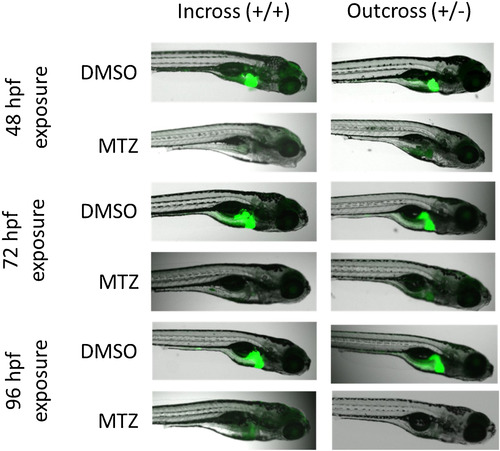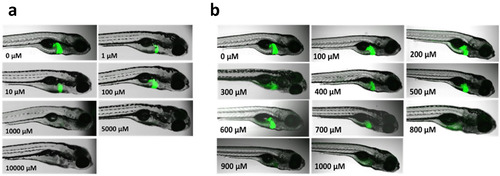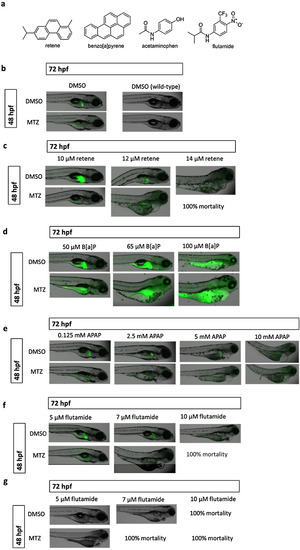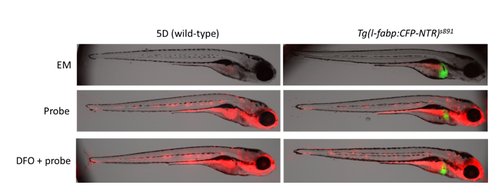- Title
-
Investigating the application of a nitroreductase-expressing transgenic zebrafish line for high-throughput toxicity testing
- Authors
- Chlebowski, A.C., La Du, J.K., Truong, L., Massey Simonich, S.L., Tanguay, R.L.
- Source
- Full text @ Toxicol Rep
|
Comparison of incrossed (homozygous positive) and outcrossed (heterozygous) Tg(l-fabp:CFP-NTR)s891 zebrafish. Embryos were exposed to either DMSO or 10 mM metronidazole (MTZ) at 48, 72, or 96 hpf until imaging at 120 hpf. Presence of hepatocytes is indicted by green fluorescence. |
|
Dose-response of Tg(l-fabp:CFP-NTR)s891 zebrafish embryos exposed to metronidazole (MTZ) at 96 hpf, and imaged at 120 hpf, at a broad (a) and refined (b) range of MTZ concentrations. Ablation of hepatocytes was assessed based on visible green fluorescent signal, where a decreasing fluorescent signal indicates hepatocyte ablation. |
|
Time course of tissue ablation (a) and regeneration (b) using 10 mM metronidazole (MTZ) in the hepatocytes of Tg(l-fabp:CFP-NTR)s891 zebrafish. For the ablation study, embryos were dosed at 96 hpf with 10 mM MTZ, and ablation was evaluated by visible fluorescence, following continuous exposure until the indicated time point. For the regeneration study, embryos were exposed to 10 mM MTZ from 96 to 120 hpf, then rinsed and moved to clean media, with imaging at the indicated time points after MTZ removal. The presence of hepatocytes is indicated by green fluorescence. |
|
Co-exposures with 10 mM metronidazole (MTZ) in Tg(l-fabp:CFP-NTR)s891 and wild-type zebrafish embryos. Structures of all compounds tested are shown in (a). Embryos were exposed to MTZ at 48 hpf, and to 1% DMSO (1.5% DMSO-exposed animals were phenotypically indistinguishable) (b), retene (c), benzo[a]pyrene (B[a]P) (d), acetaminophen (APAP) (e), or flutamide (f) at 72 hpf. Additionally, wild-type embryos were exposed to flutamide (g). Imaging and evaluations were done for all animals at 120 hpf. Concentrations tested but not shown resulted in 100% mortality both in the presence and absence of MTZ. |
|
Fluorescent patterns observed in Tg(l-fabp:CFP-NTR)s891 and wild-type embryos following treatment with the Enzo Hypoxia Detection Kit, with exposure to embryo media (EM), the red fluorescent probe included in the kit, or the probe coupled with deferoxamine (DFO), a hypoxia inducer. Embryos were exposed at 96 hpf for 24 hours until 120 hpf. Red fluorescence indicates nitroreductase activity, Green fluorescence indicates the livers of the Tg(l fabp:CFP-NTR)s891 zebrafish. |





